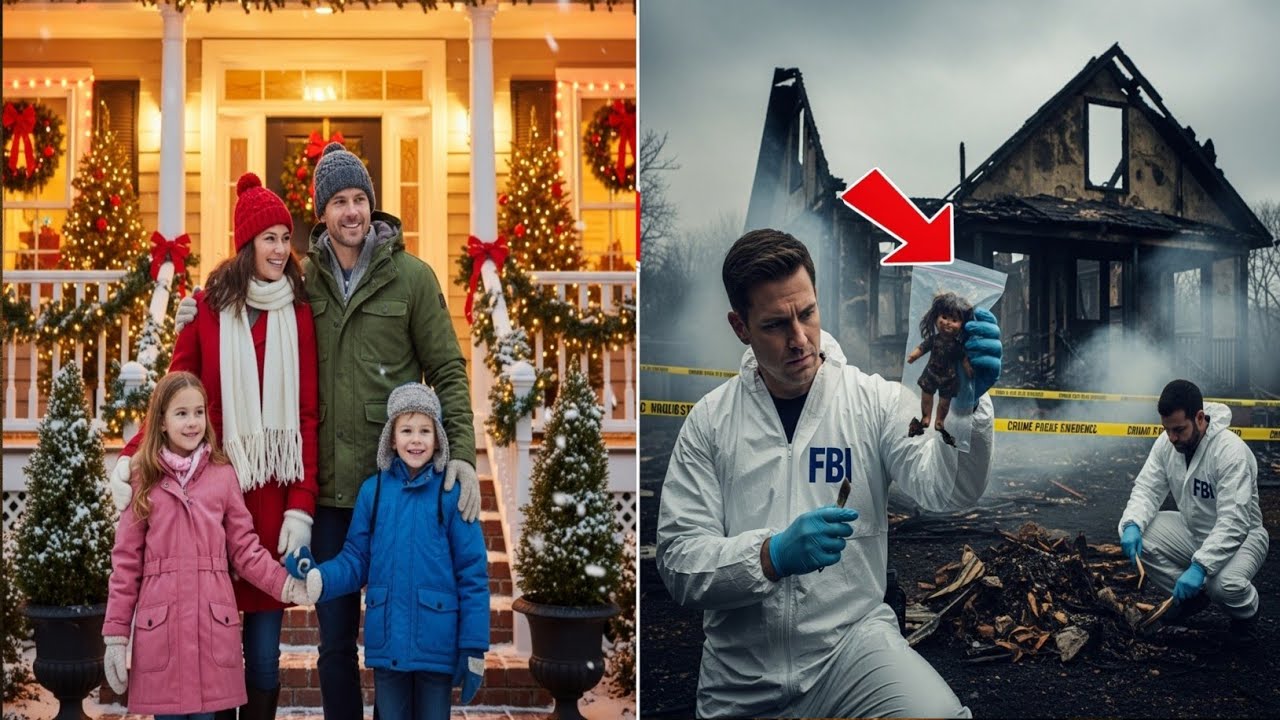The Christmas Night That Stole Five Children and Broke a Family Forever
Picture this: It’s Christmas Eve 1945, and the Sodder family is tucked into their cozy West Virginia home, filled with holiday joy. The kids are playing with new toys, the Christmas lights are glowing, and the world feels right. But by morning, their house is a pile of ashes, and five children—Maurice, Martha, Louis, Jennie, and Betty—are gone. No bodies, no traces, just… nothing. A fire that didn’t burn hot enough to erase all evidence. A missing ladder. A cut phone line. A chilling phone call with a stranger’s laugh in the dead of night. And threats from strangers who didn’t like their father’s bold opinions. For 79 years, this mystery has haunted a small town, with whispers of kidnapping, revenge, or something even darker. Now, new evidence has cracked the case wide open, raising questions no one saw coming. Were those kids really lost to the flames, or did they vanish into a secret someone’s kept all these years?
👉 Unravel the chilling details of a case that’s gripped hearts for decades. Click to discover what’s been uncovered!

On Christmas Eve 1945, the Sodder family’s home in Fayetteville, West Virginia, was a warm, bustling place. George and Jennie Sodder, Italian immigrants who had built a life in America, were surrounded by nine of their ten children. The house was filled with holiday cheer—presents unwrapped, Christmas lights twinkling, and the kids playing with new toys. But by the early hours of Christmas Day, their world would collapse in flames, and five of their children—Maurice (14), Martha (12), Louis (9), Jennie (8), and Betty (5)—would vanish, leaving behind one of America’s most perplexing unsolved mysteries. For nearly eight decades, the case has haunted investigators, amateur sleuths, and the Sodder family. Now, new evidence has reopened the case, stirring hope and questions once again.
A Night of Celebration Turned Nightmare
The Sodder family was the picture of the American Dream. George, who had worked his way up from a railroad laborer to owning a small trucking company, and Jennie, a devoted mother, raised their ten children in a two-story home in Fayetteville, a tight-knit community where many Italian-American families had settled. George was outspoken, particularly about his disdain for Italy’s fascist dictator, Benito Mussolini, which didn’t always sit well with some of his neighbors. Still, life was good, and Christmas Eve 1945 was meant to be a joyful night.
Around 10 p.m., George and Jennie went to bed with their youngest, two-year-old Sylvia. The older boys, John (23) and George Jr. (16), were already asleep after a long day working at the family business. Marion, the 19-year-old daughter, stayed up with the five younger siblings—Maurice, Martha, Louis, Jennie, and Betty—who were excited to play with their new toys. By midnight, the house was quiet, everyone asleep except for Marion, who dozed off on the couch.
At 12:30 a.m., Jennie was startled awake by the phone ringing. She trudged downstairs to answer, only to hear a woman’s voice asking for someone she didn’t know, followed by a “weird laugh.” Thinking it was a prank, Jennie hung up, but something else caught her attention. The lights were still on, the curtains weren’t drawn, and the front door was unlocked—things the kids were supposed to handle before bed. Annoyed but exhausted, she fixed everything and went back to sleep.
Half an hour later, around 1 a.m., Jennie woke again, this time to a loud bang on the roof, like something heavy had landed and rolled off. She brushed it off and drifted back to sleep. But minutes later, the smell of smoke jolted her awake. She found flames pouring from George’s office on the first floor. The fire was spreading fast. Jennie, George, Sylvia, Marion, John, and George Jr. scrambled out of the house, but the staircase to the attic, where the five younger children slept, was already engulfed.
George tried everything to save them. He ran to grab the ladder always kept against the house, but it was gone. He tried to drive his coal trucks to the house to climb onto the roof, but neither would start, despite working fine the day before. In desperation, he broke a window, cutting his arm, but the smoke and flames were too intense to reach the attic. Neighbors called the fire department, but in a small town still recovering from World War II, the response was agonizingly slow. The fire truck didn’t arrive until 8 a.m., seven hours later, by which time the house was nothing but ash.
A Mystery Deepens
When investigators sifted through the rubble, they expected to find the remains of the five children. Instead, they found nothing—no bones, no teeth, nothing to suggest the children had perished in the fire. The fire chief claimed the blaze had been hot enough to cremate the bodies completely, but the Sodders weren’t convinced. Human bones can withstand intense heat, and the fire, which burned for less than an hour before the house collapsed, didn’t seem hot enough to obliterate all traces of five children.
Other oddities piled up. The official report blamed faulty wiring, but the family’s Christmas lights had stayed on during the fire’s early stages, which wouldn’t have happened if the electrical system had failed. A telephone repairman later told the Sodders their phone line hadn’t burned but had been cut, requiring someone to climb a pole 14 feet high to do it. The missing ladder was found 75 feet away, down an embankment. Months later, Sylvia found a strange rubber object in the yard, which George identified as resembling a “pineapple bomb,” a type of incendiary device used in wartime. A bus driver passing through Fayetteville that night later claimed he saw people throwing “balls of fire” at the house.
The Sodders began to suspect something far more sinister than a tragic accident. George recalled threats he’d received in the months before the fire. A life insurance salesman, after being turned away, warned that George’s house would “go up in smoke” and his children would be “destroyed” because of his anti-Mussolini remarks. Another man, posing as a job seeker, had pointed out George’s fuse boxes, saying they’d “cause a fire someday,” even though the house had recently been rewired and inspected. Strange cars had been seen near the house, with occupants watching the younger Sodder children as they returned from school.
A Family’s Unyielding Search
Convinced their children might still be alive, George and Jennie refused to accept the official narrative. They hired private investigators, posted a billboard along Route 16 with photos of the missing children and a $5,000 reward, and followed every lead, no matter how small. In 1949, they excavated the site with a pathologist, who found a few bone fragments, but these were later determined to be unexposed to fire, raising further doubts. In 1968, an anonymous letter arrived with a photo of a young man who resembled an older Louis Sodder, claiming he was alive. The family pursued it, but the lead went cold.
Theories abounded. Some speculated the Sicilian Mafia, angered by George’s criticism of Mussolini, had orchestrated the fire and kidnapped the children as revenge. Others believed the children were taken and raised under new identities, possibly within Italian-American communities. Sightings were reported over the years—a woman claiming she saw the children in a car that night, another saying they were with strangers in a nearby town—but none led to answers.
The Sodders never rebuilt their home, turning the site into a memorial garden. Jennie tended it until her death in 1989, and the billboard stood until then, a haunting reminder of their loss. George died in 1969, still searching. The surviving siblings, especially Sylvia, who passed away in 2021, held onto hope that their brothers and sisters had survived.
New Evidence Sparks Hope
In 2025, nearly 80 years after the fire, new evidence has prompted authorities to reopen the case. While specific details remain under wraps, sources suggest advancements in forensic technology and fresh witness accounts have shed light on the mystery. Could DNA analysis of the bone fragments found in 1949 yield new clues? Or have long-buried secrets from Fayetteville’s past resurfaced? The Sodder family’s descendants, particularly Sylvia’s daughter Jennie Henthorn, remain cautiously optimistic. “I don’t think they perished that night,” Henthorn told The Independent in 2022. “But if they’re still here, I don’t think they’re in West Virginia.”
A Mystery That Endures
The Sodder children’s disappearance is a puzzle that defies easy answers. Was it a tragic fire exacerbated by a series of bizarre coincidences? Or was it a calculated act of arson and kidnapping, tied to George’s political views or a local grudge? The absence of remains, the cut phone line, the missing ladder, and the strange threats all point to something more than an accident. For now, the reopened investigation offers a flicker of hope that the truth, however elusive, may finally come to light.





